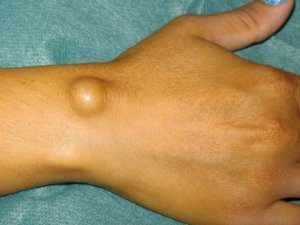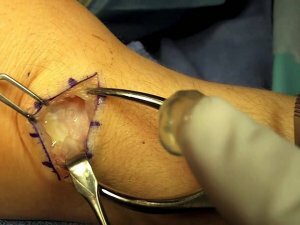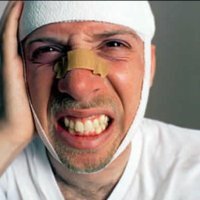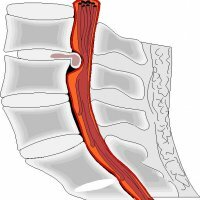The tendon ganglion
 The tendon ganglion( hygroma) is a benign, tumor, cyst-like neoplasm, occurs in the area of tendon sheaths or joints. Most often the tendon ganglion is formed on the back of the hand, but also cases of hygroma of the knee joint are more common, less often on the back side of the foot. There were no recorded cases of ganglion degeneration into a malignant tumor.
The tendon ganglion( hygroma) is a benign, tumor, cyst-like neoplasm, occurs in the area of tendon sheaths or joints. Most often the tendon ganglion is formed on the back of the hand, but also cases of hygroma of the knee joint are more common, less often on the back side of the foot. There were no recorded cases of ganglion degeneration into a malignant tumor.
In most cases, the cause and the development of the tendon ganglion is a constant effect( eg, friction or pressure) on a specific area, which is why this disease is often called an occupational disease.
In essence, the hygroma is a degenerative synovial cyst. So, the tendon ganglion symptoms, treatment and all that you need to know about this disease. Symptoms, treatment and diagnosis of hygroma are important enough, although the tendon ganglion itself is not considered dangerous, but it can cause pain during tendon work and often becomes noticeable visually, and in the advanced stages the blood vessels become squeezed, which leads to stagnation of blood in theVeins and pain. When palpation ganglion is defined as a tumor-like, rounded and inactive formation with clear boundaries. Occurs in the joint region and differs in a firm-elastic consistency.
When the tendon ganglion is still small, the patient usually does not experience any discomfort. But with the increase in size, there are pains, usually characterized as blunt and aching, which worsen more during exercise.
Skin over the site of formation of tendon gaglia can become rough and dense, but cases when the skin remains unchanged are also not uncommon.
Species of the tendon ganglion
Ganglion possesses a connective tissue capsule, often it is multilayered. Inside the capsule consists of cavities, which can be several or only one. In these cavities there is a thickened synovial fluid.
There are several types of ganglion:
- Valve - in the place of connection of the capsule of the hygroma and the maternal shell a valve is formed. When the pressure in the parental cavity is increased by loads or trauma, the synovial fluid begins to flow into the ganglion cavity, but does not retreat, as it is blocked by the valve.
- Sustest - the tendon ganglion cavities have joints together with the tendon sheath or joint. In such cases, the fluid from the hygroma, from time to time, pours out and fills the maternal cavity.
- Isolated - in this case the ganglion cavity is completely isolated and separated from the maternal membrane. But still has a place of fusion with it.
Treatment of the ganglion
 There are non-operative methods for treating the tendon ganglion, but usually they are resorted to only while the hygroma is still small. One such method is massage and special medicines. Usually due to professional massage the hygroma is significantly reduced or even completely destroyed. Sometimes medications are injected directly into the body of the hygroma.
There are non-operative methods for treating the tendon ganglion, but usually they are resorted to only while the hygroma is still small. One such method is massage and special medicines. Usually due to professional massage the hygroma is significantly reduced or even completely destroyed. Sometimes medications are injected directly into the body of the hygroma.
Tendon ganglion, conservative and surgical treatment:
- Conservative treatment of .When the hygroma is still small, the method of its mechanical crushing can be applied. This is a very painful procedure, which is also generous in relapses. The fact is that when crushed, the fluid in the ganglion cavity can pour into the surrounding tissues. Sometimes inflammatory reactions or even suppuration may begin. A damaged shell, after a period of time can recover and then most likely there will be a new hygroma. In official medicine, this method is almost not used since the 80s of the last century because of its cruelty, morbidity and inefficiency. Another method of conservative treatment is the puncture of the hygroma, this method is used not only for therapeutic purposes( when for some reason there is no possibility to perform the operation), and for diagnosis( the contents of the ganglion are taken for research).For treatment of the ganglion, fluid is pumped out, then the cavity is filled with specialized drugs that facilitate sclerosis of the ganglion capsule. After that, a bandage and gypsum are placed on the place where the hygroma is to immobilize the limb for a week. Immobilization is important to reduce the production of synovial fluid.
- Surgical treatment. When conservative methods are ineffective, and the hygroma causes pain, grows or is too prominent, then only surgical intervention remains - bursectomy. In this operation, the synovial bag is completely cut, then the tendon ganglion and all its membranes are removed. The operation can be performed under local anesthesia, outpatient. An anesthetic is injected around the site of the formation of the ganglion and the whole operation takes no more than half an hour. However, unfortunately, it is impossible to conduct a complete and adequate removal of the hygroma in an outpatient operation, since pain sensitivity remains inside the tissues. It is best, if the operation is performed under general anesthesia, then there will be a complete deactivation of the sensitivity of the tissues. After the operation, the place where the hygroma was, is sealed and in most cases heals in just 10 or 12 days.
It is very important that after the operation to remove the tendon ganglion, the operated limb site was firmly fixed, using a gypsum longi, which is removed after 2-3 weeks. While the scar is being formed, one should not allow limb movements in the area where the ganglion was, otherwise there would be a risk of recurrence.



